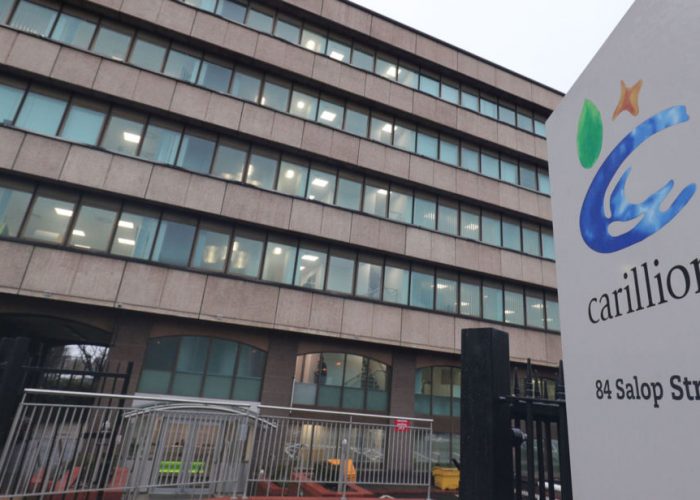



Carillion’s head office in Wolverhampton
Lenders to Carillion, the construction giant which collapsed into liquidation on Monday, are facing losses of up to £2bn, making it one of the costliest corporate insolvencies for years.
Sky News has learnt that a complex series of financing arrangements for subsidiaries of Carillion mean that the total exposure of its banking syndicate is far higher than the £900m headline debt figure carried by the listed construction group.
Industry sources said that £2bn was “a sensible estimate” of the huge losses confronting the company’s banks, following the failure of last-ditch rescue talks over the weekend.
Carillion’s large syndicate of lenders includes Barclays, HSBC, Lloyds Banking Group and Santander UK, as well as a host of overseas firms.
Lenders were asked for roughly £20m to keep Carillion trading for another week, according to sources, but the absence of Government support for the company made the proposal unworkable.
The construction group’s lenders are not the only creditors facing financial pain from its collapse.
The UK’s pensions lifeboat faces a hit of up to £900m to cover the cost of paying compensation to thousands of pension scheme members, according to initial estimates.
If the Pension Protection Fund’s (PPF) exposure did reach that level, it would make it the single-largest bill in the organisation’s history.
The PPF reassured employees on Monday that their benefits would be protected.
Carillion’s collapse into compulsory liquidation came after weeks of increasingly urgent discussions with the Government and the company’s lenders.
David Lidington, the Cabinet Office Minister, said it was “regrettable” that Carillion had not secured a private rescue deal but added that “taxpayers cannot be expected to bail out a private company”.
The construction group, which counted the HS2 high-speed rail link and hundreds of schools, hospitals and prisons among the public sector work it was contracted for, had seen mounting losses in recent months after mispricing a series of projects.
Wolverhampton-based Carillion is the second-largest supplier to Network Rail and maintains approximately half of the UK’s prisons as well as roughly 50,000 homes for the Ministry of Defence.
More than 19,000 UK-based employees of Carillion now face an uncertain future, although the Government insisted that they would continue to be paid through the Official Receiver.
Government sources had said that emergency talks on Sunday concluded with John Manzoni, the permanent secretary at the Cabinet Office, announcing that Carillion would not receive any special support from taxpayers.
The company’s bosses had hoped that ministers might agree to a proposal made over the weekend to guarantee payments on public sector contracts, which would enable it to borrow more money.
Carillion needed £300m of short-term funding from the end of this month, and its banks had previously indicated that they were reluctant to provide it without significant support from the Government.
As recently as Friday night, Carillion insisted it was holding “constructive discussions with a range of financial and other stakeholders regarding options to reduce debt and strengthen the group’s balance sheet”.
Philip Green, the company’s chairman, said the collapse meant it was “a very sad day for Carillion”.
As an agent of the Insolvency Service, the Official Receiver is responsible for examining the causes of corporate failure, a role that will include investigating directors’ conduct and “the business, dealings and affairs of the company”, according to a Government statement.
Carillion had issued a string of profit warnings during the last six months, sending it scrambling to raise more cash after unveiling a thumping £1.1bn loss for the half-year.
Earlier this month, the company was dealt a fresh blow when the City watchdog launched a probe into the “timeliness and content” of statements it made to the stock market about its financial position between December 2016 and July last year, when a massive profit warning sent its shares crashing by 75%. – news.sky.com